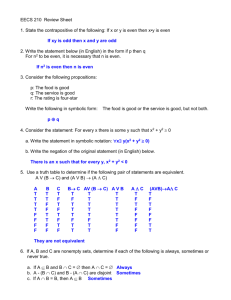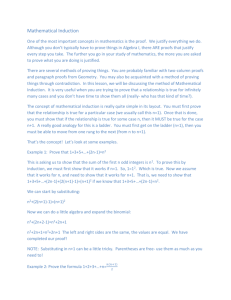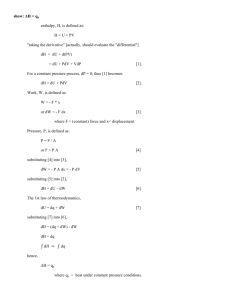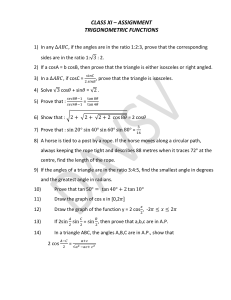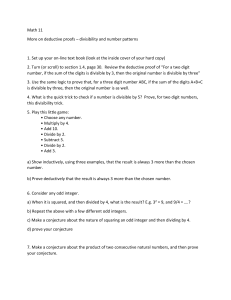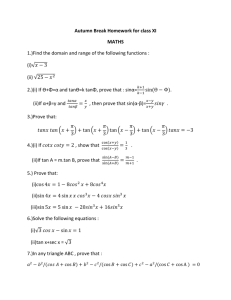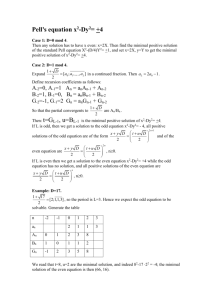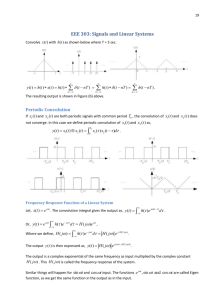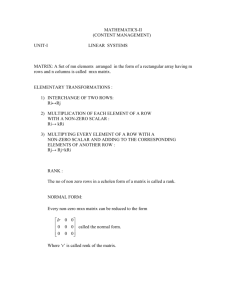Chapter I
advertisement
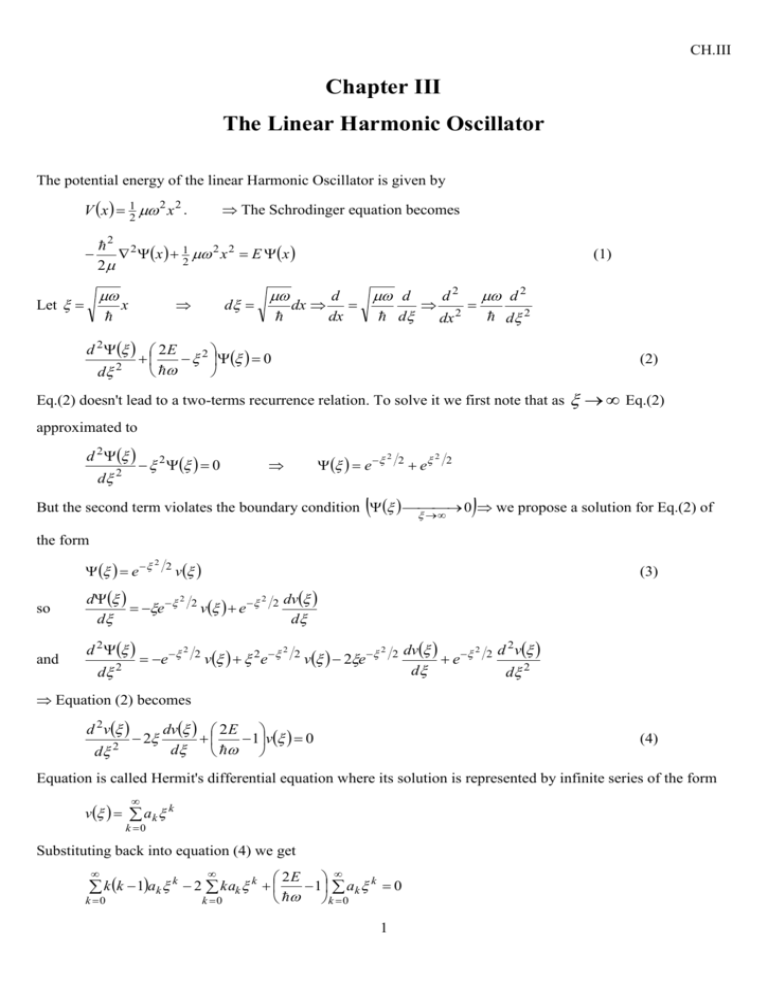
CH.III Chapter III The Linear Harmonic Oscillator The potential energy of the linear Harmonic Oscillator is given by V x 12 2 x 2 . 2 2 x 12 2 x 2 E x 2 Let The Schrodinger equation becomes d x (1) dx d d d 2 d 2 2 dx d d 2 dx d 2 2 E 2 0 2 d (2) Eq.(2) doesn't lead to a two-terms recurrence relation. To solve it we first note that as Eq.(2) approximated to d 2 d 2 2 0 e 2 2 e 2 2 0 we propose a solution for Eq.(2) of But the second term violates the boundary condition the form e so and 2 2 v 2 d e d d 2 d 2 e 2 2 (3) v e 2 2 2 v 2e dv d 2 2 v 2e 2 2 dv 2 e d 2 d 2v d 2 Equation (2) becomes d 2 v d 2 2 dv 2 E 1v 0 d (4) Equation is called Hermit's differential equation where its solution is represented by infinite series of the form v ak k k 0 Substituting back into equation (4) we get k 0 k 0 2E 1 ak k 0 k 0 k k 1ak k 2 kak k 1 CH.III Equating the coefficient of k to zero k 2k 1ak 2 2kak 2 E 1ak ak 2 0 2E 1 2k a k k 2 k 1 (5) If we set a1 0 and choosing a0 arbitrary we generate the even solution. In the other hand, choosing a1 arbitrary and letting a0 0 we generate the odd solution e 2 2 veven vodd It is clear from Eq.(5) that ak 2 2 k ak k Now let us examine the series e 2 j 0 a k 1 ak (6) 2j j! k k 0 k ! 2 k ! 1 2 2 k k k k 1! 1 2 2 2 v behaves like e as both the even and the odd series violate the boundary conditions 0. To solve this dilemma we have to terminate the series after a finite number of terms, say n, an 2 0 from Eq.(5) we get 2E 1 2n (7) If n is even a n 2 and all higher terms vanish and since the odd series get unacceptable solution we let a1 0 . If n is odd we retain only the odd series by letting a0 0 . the solution exits for integer n from Eq.(7) we get E n 12 (8) And the eigen functions are Ne 2 2 v or 2 CH.III x Ne 2 x2 H n x (9) Where H n are the Hermit's polynomials with the following properties: g x, t e t 2 H n x 2tx n 0 H n x 1n e x dn 2 dx n e x tn n! generating function 2 Rodrigues formula H n x 1n H n x Parity H n x 2 xH n x 2nH n x 0 e x2 Differential equation H n x H m x dx 2 n n! nm Orthogonality H n 1 x 2 xHn x 2nH n 1 x 0 H n x 2nH n 1 x 0 H n x 2 xH n x 2nH n x 0 Recurrence relations Now using the Rodrigues formula one can prove that H 0 x 1 H1 x 2 x H 2 x 4 x 2 2 H 3 x 8 x 3 12 x Now since the wave function given by Eq.(9) must be normalized we have 2 x x dx N e 2 2 x H n x H n x dx 1 with Using the orthogonality property we get N2 2 n n! 1 N n 2 n! n x 1 4 1 2 n n! 1 4 2 x 0 x e 4 3 3 1 x 3 1 4 e 2 x2 4 1 2 n n! H n x 2 xe 1 Eo 12 2 x2 E1 32 3 CH.III 1 4 2 2 x 2 x x 1e 4 4 2 E2 52 n ( ) Exercise: 1- Prove that And p kn x i kn 2 2 2- Prove that x 2 | n ( ) |2 n k , n 1 n 1 k , n 1 n 1 k , n 1 n k , n 1 n 12 & 4 p 2 n 12 CH.III The Dirac Notation Method Let n be the eigen ket of the system H n En n (1) With H p2 1 2 x 2 2 2 (2) Let us introduce the dimensionless coordinate and momenta operators x 2 x p and 1 2 p H p2 x2 x ipx ip ix, p But x, p 1 x, p i 2 2 H p2 x2 x ipx ip 12 and x ip a † x ip a Now let H a †a 12 (3) (4) Substituting back in Eq. (1) a †a 12 n En n a †a n 12 n En n (5) Letting a † a n n n (6) Eq.(5) becomes n 12 n En n or E n n 12 (7) To find the values of n we operate on Eq.(6) by a we get aa † a n n a n (8) From the definition of Eq.(3) it is easy to prove that a, a 1 or aa † † 1 a † a (9) Substituting Eq.(9) into Eq.(8) we get 5 CH.III 1 aa a n a n aa a n 1a n † n † (10) n From Eq.(10) we conclude that a n is also eigenket for aa† with the eigen value n 1 ,i.e., a n C n n 1 (11) By operating on Eq.(6) by a † one can prove that a † n C n n 1 (12) Now multiplying Eq.( 11) by its bra form n a † a n Cn 2 n 1 n 1 (13) Using Eq.(6), Eq.(13) becomes 2 n Cn (14) Similarly, multiplying Eq.(12) by its bra form n aa † n Cn 2 n 1 n 1 Using Eqs.(9) and (6) we get 1 n Cn 2 (15) Now from Eq.(14) we conclude n 0 there must be a nonnegative minimum value min such that ,using Eq.(11) a nmin C min nmin 1 Cmin 0 From Eq.(14) we conclude that min 0 . By applying the operators a and a † repeatedly on Eq.(6) we can generate from any given eigenket n new eigenkets with different eigen values that is integrally spaced and zero. Setting n composed of a set of positive integers n n and using Eq.(7) we obtain E n n 12 (16) Now from Eqs.(14 & 15) we have Cn n and Cn n 1 Eqs. (11 & 12) now read a n n n 1 (17) 6 CH.III a† n n 1 n 1 (18) † Equations (17) and (18) specify completely the operators a and a as the lowering (annihilation) and raising (creation) operators, respectively. Now from Eq.(3) we have and x ip a † x ip a 2 1 xi 2 pa & 2 1 x i 2 p a† Adding and subtracting the above two equations we get, respectively 2 x a a† x and 2 i p a a† a a 2 † pi 2 a † a (19) (20) Let is now evaluate the matrix elements of some operators X mn m x n X mn 2 a a m a a n † n m n 1 2 † n 1 m n 1 X mn x 2 0 1 0 1 0 2 0 0 2 0 0 3 0 3 0 0 amn m a n n m n 1 n m, n 1 0 0 a 0 0 1 0 0 2 0 0 0 0 0 3 0 0 And 7 2 n m, n 1 n 1 m, n 1 CH.III a m a † n n 1 m n 1 n 1 m, n 1 † a 0 1 0 0 † mn 0 0 2 0 Using Eq.(4) we get 0 0 0 3 0 0 0 0 H mn m H n m a † a n 12 m n n 12 mn 1 0 H 0 2 0 0 3 0 0 0 0 5 0 0 0 0 7 Let us generate some eigen functions: Using Eq.(17) we have a0 0 Expressing a in terms of x & p 1 xi p 0 0 2 2 d 2 x 2 dx 0 0 d 2 x 2 dx 0 0 1 d x 0 0 dx d 0 2 x0 0 dx Now from Eq.(18) we have Again expressing 1 d0 2 x 0 4 0 e 2 x2 2 a† 0 1 a† in terms of x & p 1 xi p o 1 2 2 1 d o 1 x 2 2 dx Substituting for o it is easy to prove that 8 CH.III 1 1 4 2 x e x 2 2 The Motion of the Wave Packets: It is known that x, t i Et Cn e n n 0 x (21) x,0 C n n x n0 If x,0 is normalized then 2 Cn 1 (22) n0 Substituting for En from Eq.(16) into Eq.(21) we get x, t i t e 2 Cn e int n x (23) n0 H x, t H x, t dx 2 2 1 H x, t 2 2 x 2 x, t dx 2 Substituting for x, t from Eq.(23) H Cn 2 n0 2 2 1 2 2 x n 2 2 x n x dx Using the Schrödinger equation we have 2 2 1 2 2 x 2 n x En n x 2 n0 H C n En n x n x dx C n En 2 n0 2 (24) From Eq. (22) and (24) we conclude the two facts that (1) The only possible results of measuring the energy of the system are the energy values En. (2) If the system is in the state x, t , the probability of obtaining the result En is equal to Cn postulate number (IV). Let us now find the expectation value of the position operator with respect to the state x, t . 9 2 as stated in CH.III x n x, t xk x, t dx C nC k e i n k t n x xk x dx n0 k 0 But n x xk x dx 2 n k , n 1 n 1 k , n 1 x n CnCn 1e it Cn1Cn e it 2 n 0 Setting Cn Cn e i n n i t n n 1 Cn Cn 1 e i t n1 n Cn Cn 1 e 2 n 0 x 2n x C n Cn1 cost n1 n (25) n 0 Let us test the last result at the limit n → ∞. At this limit we can assume n1 n & Cn1 Cn Again for n → ∞ we can write for the energy En n .Then Eq.(25) now reads 2 x 2 Cn 2 n 0 E n cost Knowing that 2 2 Cn n 0 2 En E x In classical mechanics we have x A cost x 2E 2 and E 12 2 A 2 , then cost (27) Which is similar to Eq.(26). 10 2E 2 cost (26) CH.III In chapter (I) we proved that d 1 A, H A A dt i t but x, H ip d 1 x , H x dt i p d x dt (28) Similarly d 1 p, H , and p, H 2i 2 p dt i d p 2 x dt (29) Differentiate Eq.(28) with respect to t we get d2 dt 2 x 1d p dt Using the result of Eq.(29) we get d2 dt 2 x 2 x x x o cost (30) Which is similar to Eq.(27). 11

